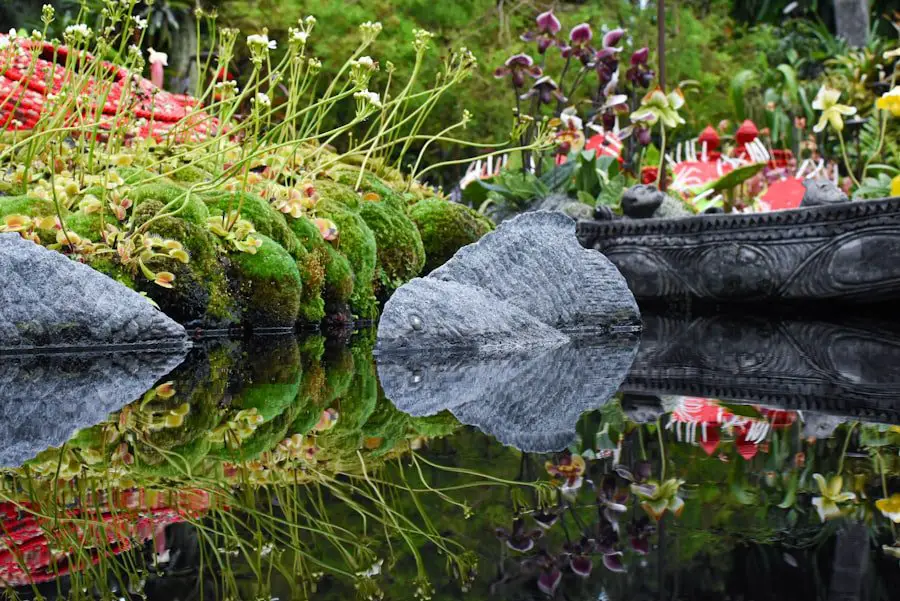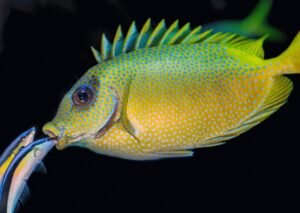Fish ponds are a popular and rewarding addition to any backyard or garden. They provide a tranquil and beautiful space, as well as the opportunity to keep and care for fish. However, before diving into the world of fish ponds, it is important to understand the basics. This article will guide you through the process of creating and maintaining a fish pond, covering everything from choosing the right location to enhancing your pond with plants and decorations.
Key Takeaways
- Fish ponds require basic understanding of location, design, species selection, water quality management, filtration systems, oxygenation, feeding, maintenance, and enhancement.
- Choosing the right location for your fish pond is crucial for its success and should consider factors such as sunlight, shade, wind, and accessibility.
- Designing your fish pond involves determining the appropriate size, shape, and depth based on the available space, intended use, and fish species.
- Selecting the right fish species for your pond depends on your goals, climate, water quality, and compatibility with other species.
- Water quality management is essential for maintaining a healthy environment for your fish and involves monitoring and adjusting pH, temperature, ammonia, nitrite, and nitrate levels.
Choosing the Right Location for Your Fish Pond
When selecting a location for your fish pond, there are several factors to consider. First and foremost, you want to choose a spot that receives adequate sunlight. Sunlight is essential for the growth of aquatic plants and algae, which provide oxygen and food for your fish. Additionally, sunlight helps to regulate the temperature of the water, which is crucial for fish health.
Shade is also an important consideration when choosing a location for your fish pond. While some shade can be beneficial in preventing excessive algae growth and keeping the water temperature cool, too much shade can inhibit plant growth and limit sunlight exposure. It is important to strike a balance between sunlight and shade in order to create a healthy environment for your fish.
Wind is another factor to consider when selecting a location for your fish pond. Strong winds can cause excessive evaporation, leading to water loss and potential stress for your fish. Additionally, wind can stir up debris and create waves, which can disrupt the ecosystem of your pond. It is best to choose a location that is sheltered from strong winds to ensure the stability and health of your fish pond.
Designing Your Fish Pond: Size, Shape, and Depth
The size and shape of your fish pond will depend on several factors, including available space, personal preference, and intended use. If you plan on keeping a large number of fish or incorporating other aquatic animals such as turtles or frogs, you will need a larger pond. On the other hand, if you are looking for a small and simple pond for a few fish, a smaller size may be sufficient.
When it comes to shape, there are endless possibilities. Some popular options include rectangular, circular, and kidney-shaped ponds. The shape of your pond should complement the overall design of your backyard or garden and create a visually pleasing aesthetic.
Depth is an important consideration when designing your fish pond. The depth of your pond will depend on the type of fish you plan to keep. Different species have different depth requirements, so it is important to research the specific needs of the fish you are interested in. In general, a depth of at least 3 feet is recommended to provide adequate space for fish to swim and hide, as well as to protect them from predators and extreme temperature fluctuations.
Selecting the Right Fish Species for Your Pond
| Fish Species | Water Temperature Range | Feeding Habits | Maximum Size | Compatibility with Other Fish |
|---|---|---|---|---|
| Tilapia | 68-86°F | Omnivorous | 24 inches | Compatible with most fish species |
| Catfish | 70-85°F | Omnivorous | 24 inches | Compatible with most fish species |
| Bluegill | 65-85°F | Omnivorous | 12 inches | Compatible with most fish species |
| Bass | 65-85°F | Carnivorous | 24 inches | Not compatible with smaller fish species |
| Koi | 59-77°F | Omnivorous | 36 inches | Compatible with most fish species |
Choosing the right fish species for your pond is crucial for the success and sustainability of your ecosystem. There are several factors to consider when making this decision. First and foremost, you need to consider the climate and water conditions in your area. Some fish species are more tolerant of cold temperatures, while others thrive in warmer climates. It is important to choose fish that are well-suited to your specific environment.
Compatibility is another important factor to consider when selecting fish species for your pond. Some species may be aggressive or territorial, while others may be more peaceful and social. It is important to choose fish that will coexist harmoniously in order to maintain a balanced and healthy ecosystem.
Additionally, you should consider the size and growth rate of the fish species you are interested in. Some species may grow quite large over time, requiring a larger pond or additional space. It is important to plan ahead and ensure that your pond can accommodate the size and needs of the fish you choose.
Water Quality Management: Maintaining the Perfect Environment for Your Fish
Water quality is of utmost importance when it comes to the health and well-being of your fish. Poor water quality can lead to stress, disease, and even death. Therefore, it is essential to monitor and maintain the water quality in your fish pond.
There are several key parameters to consider when it comes to water quality. These include temperature, pH level, ammonia and nitrite levels, and oxygen levels. Each of these factors plays a crucial role in the overall health and stability of your pond ecosystem.
Monitoring water quality can be done through regular testing using test kits or meters. These tools will allow you to measure the various parameters and make any necessary adjustments. It is important to establish a regular testing schedule and keep a record of the results in order to track any changes or trends over time.
Maintaining water quality involves a combination of regular maintenance tasks and proactive measures. Regular maintenance tasks include removing debris, such as leaves and algae, from the pond, as well as performing partial water changes to dilute any accumulated toxins. Proactive measures include adding beneficial bacteria to help break down waste and maintain a healthy balance of nutrients in the water.
Filtration Systems: Choosing the Best Option for Your Pond

Filtration systems are an essential component of any fish pond. They help to remove debris, excess nutrients, and harmful substances from the water, ensuring a clean and healthy environment for your fish.
There are several types of filtration systems available, including mechanical filters, biological filters, and UV sterilizers. Mechanical filters remove physical debris from the water, such as leaves and fish waste. Biological filters provide a habitat for beneficial bacteria that break down harmful substances, such as ammonia and nitrite. UV sterilizers use ultraviolet light to kill algae and harmful bacteria.
When selecting a filtration system for your pond, there are several factors to consider. These include the size of your pond, the number and type of fish you plan to keep, and your budget. It is important to choose a filtration system that is appropriately sized for your pond and capable of handling the waste load of your fish.
Oxygenation and Aeration: Keeping Your Fish Healthy
Oxygenation and aeration are crucial for the health and well-being of your fish. Fish require oxygen to breathe, and without adequate oxygen levels, they can become stressed, lethargic, and even die.
There are several methods of oxygenation and aeration that can be used in a fish pond. These include air pumps, waterfalls, fountains, and surface agitation. Air pumps provide a constant supply of oxygen by pumping air into the water. Waterfalls and fountains create turbulence and surface agitation, which helps to increase oxygen exchange. Surface agitation can also be achieved through the use of diffusers or bubblers.
The method of oxygenation and aeration you choose will depend on the size and design of your pond, as well as personal preference. It is important to ensure that there is adequate oxygenation and aeration throughout the entire pond, as fish require oxygen in all areas.
Feeding Your Fish: Tips and Tricks for Optimal Nutrition
Proper nutrition is essential for the health and growth of your fish. Feeding your fish a balanced diet will help to ensure that they receive all the necessary nutrients they need to thrive.
When it comes to feeding your fish, it is important to choose a high-quality fish food that is appropriate for the species you are keeping. Different species have different dietary requirements, so it is important to research the specific needs of your fish.
In addition to choosing the right food, it is also important to feed your fish the right amount. Overfeeding can lead to poor water quality, obesity, and other health issues. It is best to feed your fish small amounts multiple times a day, rather than one large feeding. This will help to prevent overeating and ensure that all fish have a chance to eat.
Pond Maintenance: Cleaning and Troubleshooting Common Issues
Regular maintenance is essential for the health and longevity of your fish pond. This includes cleaning tasks, as well as troubleshooting common issues that may arise.
Cleaning tasks include removing debris, such as leaves and algae, from the pond. This can be done using a net or skimmer. It is important to remove debris regularly to prevent it from decomposing and affecting water quality.
Troubleshooting common issues may involve addressing problems such as excessive algae growth, water discoloration, or fish illness. These issues can often be resolved through adjustments to water quality parameters, such as pH or nutrient levels, or through the use of appropriate treatments or medications.
Enhancing Your Fish Pond: Adding Plants, Decorations, and Features
Adding plants, decorations, and features to your fish pond can enhance its beauty and create a more natural and inviting environment for your fish. Plants provide oxygen, shade, and hiding places for your fish, as well as helping to maintain water quality by absorbing excess nutrients. There are many aquatic plants to choose from, including floating plants, submerged plants, and marginal plants.
Decorations such as rocks, driftwood, and statues can add visual interest and create a focal point in your pond. These decorations can also provide additional hiding places for your fish and create a more naturalistic habitat.
Features such as waterfalls, fountains, and lighting can add movement, sound, and ambiance to your pond. These features not only enhance the aesthetic appeal of your pond but also provide additional oxygenation and aeration.
Creating and maintaining a fish pond can be a rewarding and fulfilling endeavor. By understanding the basics of fish pond design and care, you can create a beautiful and healthy environment for your fish to thrive. From choosing the right location and fish species to maintaining water quality and enhancing your pond with plants and decorations, there are many factors to consider. With proper planning and attention to detail, you can create a fish pond that brings joy and tranquility to your outdoor space. So why wait? Dive in and start your own fish pond today!
If you’re interested in creating a beautiful fish pond in your backyard, you’ll definitely want to check out this informative article from Just Tidings. They provide expert tips and advice on how to design and maintain a stunning fish pond that will be the envy of your neighbors. From choosing the right fish species to selecting the perfect plants and accessories, this article covers it all. Don’t miss out on this valuable resource! Click here to read more about creating your dream fish pond.




















+ There are no comments
Add yours